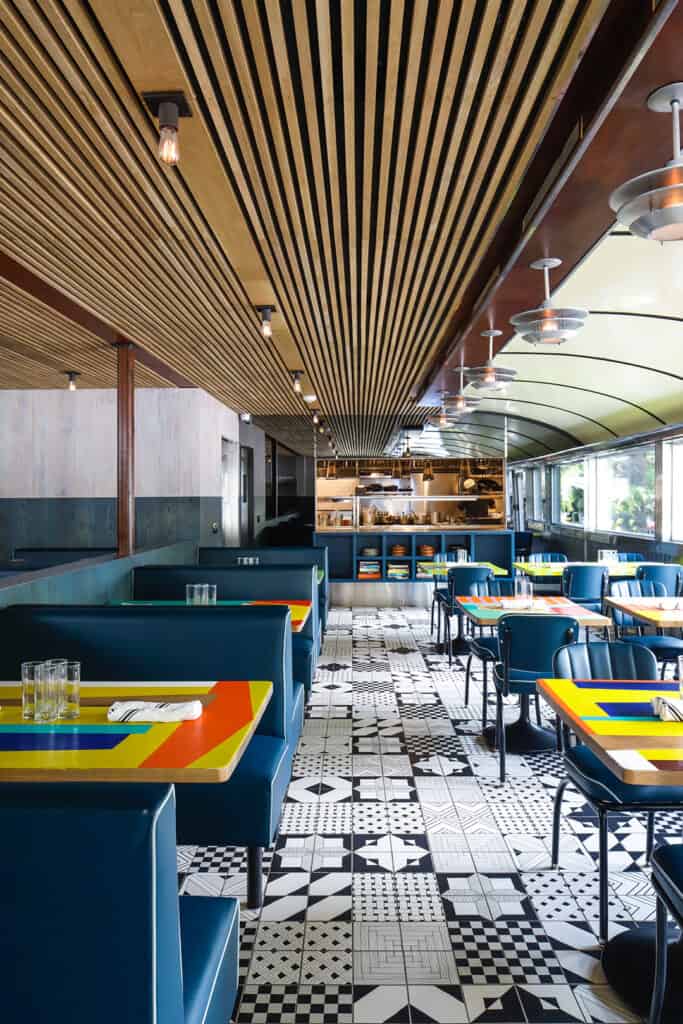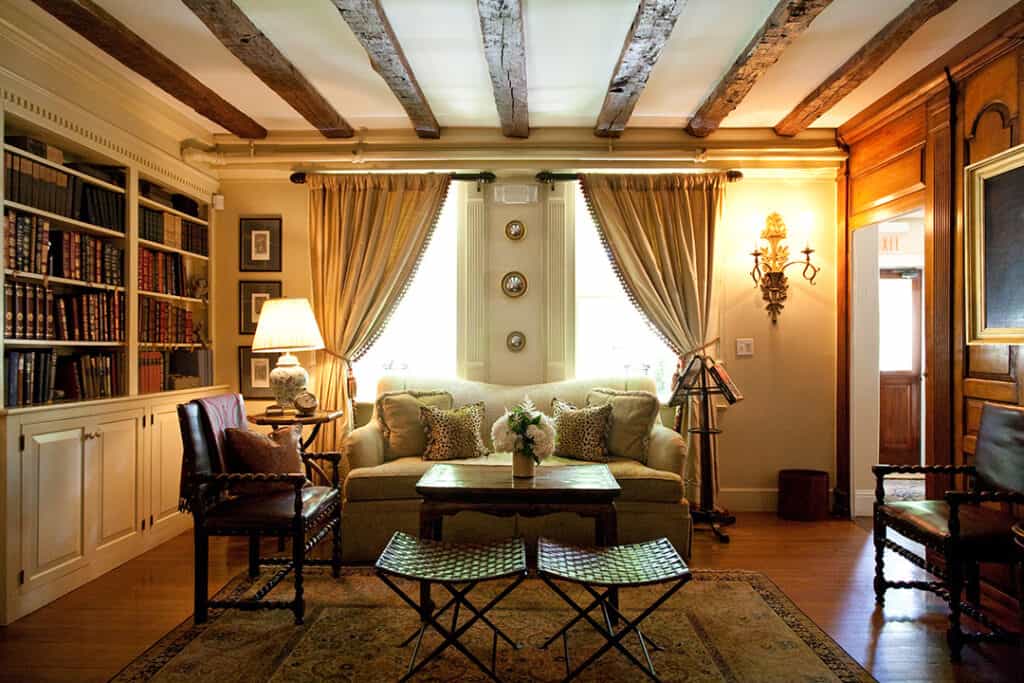Five Architecturally Notable South Fork Restaurants
Sure, the food is important, but what about the space itself? Some of the Hamptons most notable dining experiences can be measured based on their architecture. Whether it’s windows that let in the light, retracting glass walls that expand the line of vision, or hand-hewn beams that bring back a sense of history, some of our favorite architectural features in South Fork restaurants are ones that surprise and delight us when it comes to what to expect while dining.

Cass Calder Smith Architecture, the design team responsible for the look at Nick & Toni’s and Townline BBQ, also designed Coche Comedor, the restaurant in Amagansett that was once a diner. Architectural elements abound at Coche, from the rounded ceiling to the stainless steel details to the original light fixtures. Additional elements were added, too: imported tile, colorful booths, and a steel bar. The architecture firm opened the wall facing La Fondita, the group’s neighboring restaurant, creating a glass façade and the illusion of more space. In summer, the wall retracts, opening a patio between the two restaurants.
Regardless of the season, 1770 House’s greatest architectural feature is its hand-hewn beams. The East Hampton restaurant, which is also an inn, dates back to the early Colonial period: 1663. Once the home of William Fithian, the converted space retains much of its original historic feel, with period details, like working fireplaces, intact. But its beams, which warm the space, both in summer and in winter, are among the restaurant’s greatest architectural features, thick tranches of wood that run across the ceilings and that contribute to its unique and special feel.

Southampton’s Manna at Lobster Inn enjoys a built-in architectural feature: a view of the water. Windows wrapping all around the restaurant, which features a raw bar, appetizers, handhelds, entrees, and, naturally, a selection of lobsters, allow in the most important element of the restaurant: the water. From nearly any vantage point in the restaurant, you can look out and see the cerulean of the water, an architectural feat that hammers home that familiar adage. It’s all about the location.
At Rosie’s, in Amagansett, a restaurant serving breakfast, lunch, and dinner, soothing design notes and small architectural moves offer a cool and captivating dining room that mimics the seasonal and local menu. Arched doorways and mirrors give the illusion of more space in this petite dining room, and stacked blue glazed ceramic tile, used on the walls of the restaurant, summon a bistro near the beach in Mexico. It’s not hard to imagine a margarita in hand (so why not order the matcha mezcal marg, made with Ilegal Joven mezcal, Cointreau, lime, matcha, and lava salt?).
East Hampton’s Maidstone, within the Maidstone hotel, offers a cozy fireplace, a statement-making marble-topped bar, and a menu that embraces local Long Island flavors. In the back dining room, floor-to-ceiling windows flood the space with natural light. The menu is in flux, but diners can expect such dishes as seared salmon, steamed mussels, burrata, and branzino.












!['The Maples' is a prestigious generational compound of two extraordinary estates: 18 Maple and 22 Maple. This rare offering, designed by luxury architect Lissoni partners New York and developed by visionaries Alessandro Zampedri-CFF Real Estate and JK Living, redefines opulence with the highest quality of craftsmanship and captivating views of the Atlantic Ocean. Represented by @nycsilversurfer and @challahbackgirl of @douglaselliman. [link in bio]](https://hamptonsrealestateshowcase.com/wp-content/uploads/sb-instagram-feed-images/438891010_1083749139481747_7890082604579275354_nfull.jpg)
![Featuring 360-degree water views on Mecox Bay, the Atlantic Ocean and Channel Pond, 1025 Flying Point offers the ultimate beach cottage that is flooded with natural light. With panoramic views, proximity to the ocean, and a private walkway to Mecox bay for kayaking or paddle boarding, this truly is a special retreat. Represented by @ritcheyhowe.realestate and @hollyhodderhamptons of @sothebysrealty. [link in bio]](https://hamptonsrealestateshowcase.com/wp-content/uploads/sb-instagram-feed-images/438994305_737511778456166_4602476013493875279_nfull.jpg)
![Attention advertisers! 📣 Secure your spot in the highly anticipated Memorial Day edition #HRES. Reach thousands of potential clients and showcase your brand in one of the most sought-after publications in the Hamptons, NYC, Palm Beach, and beyond. Contact us now to reserve your ad space! [link in bio]](https://hamptonsrealestateshowcase.com/wp-content/uploads/sb-instagram-feed-images/438549843_275102939023235_6718257301437562124_nfull.jpg)
![You eat with your eyes, and on the East End, it’s important that what you eat looks just as good as how it tastes. At @rosies.amagansett, the restaurant itself is plenty photo-worthy with blue ceramic tiling and yellow and white striped fabric wallpaper. But for a dish that will light up your photos, head directly to the salmon tartare! [link in bio]](https://hamptonsrealestateshowcase.com/wp-content/uploads/sb-instagram-feed-images/437094269_7296727147115953_1594410326824303644_nfull.jpg)

![We were honored to be the media sponsor for @blackmountaincapital's open house event with @jameskpeyton and @jfrangeskos at 11 Dering Lane in East Hampton! Other sponsors included @landrover, Feline Vodka, @rustikcakestudio, @la_parmigiana, @lahaciendamexicangrill11968, @homesteadwindows, Stone Castle, @talobuilders, and @thecorcorangroup.
A big thank you Carrie Brudner of Black Mountain Capital for putting together this fabulous event! [link in bio]](https://hamptonsrealestateshowcase.com/wp-content/uploads/sb-instagram-feed-images/437081213_762912965932136_6847332836522786568_nfull.jpg)

![Blooms Galore at the Long Island Tulip Festival! 🌷✨ Mark your calendars for April 15th as the vibrant tulips at @waterdrinkerlongisland burst into full bloom! Enjoy a day filled with colorful splendor, food trucks, live music, and more. [link in bio]](https://hamptonsrealestateshowcase.com/wp-content/uploads/sb-instagram-feed-images/437083429_974242677583725_6855805712693638343_nfull.jpg)
